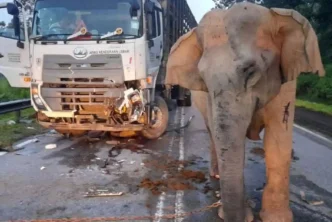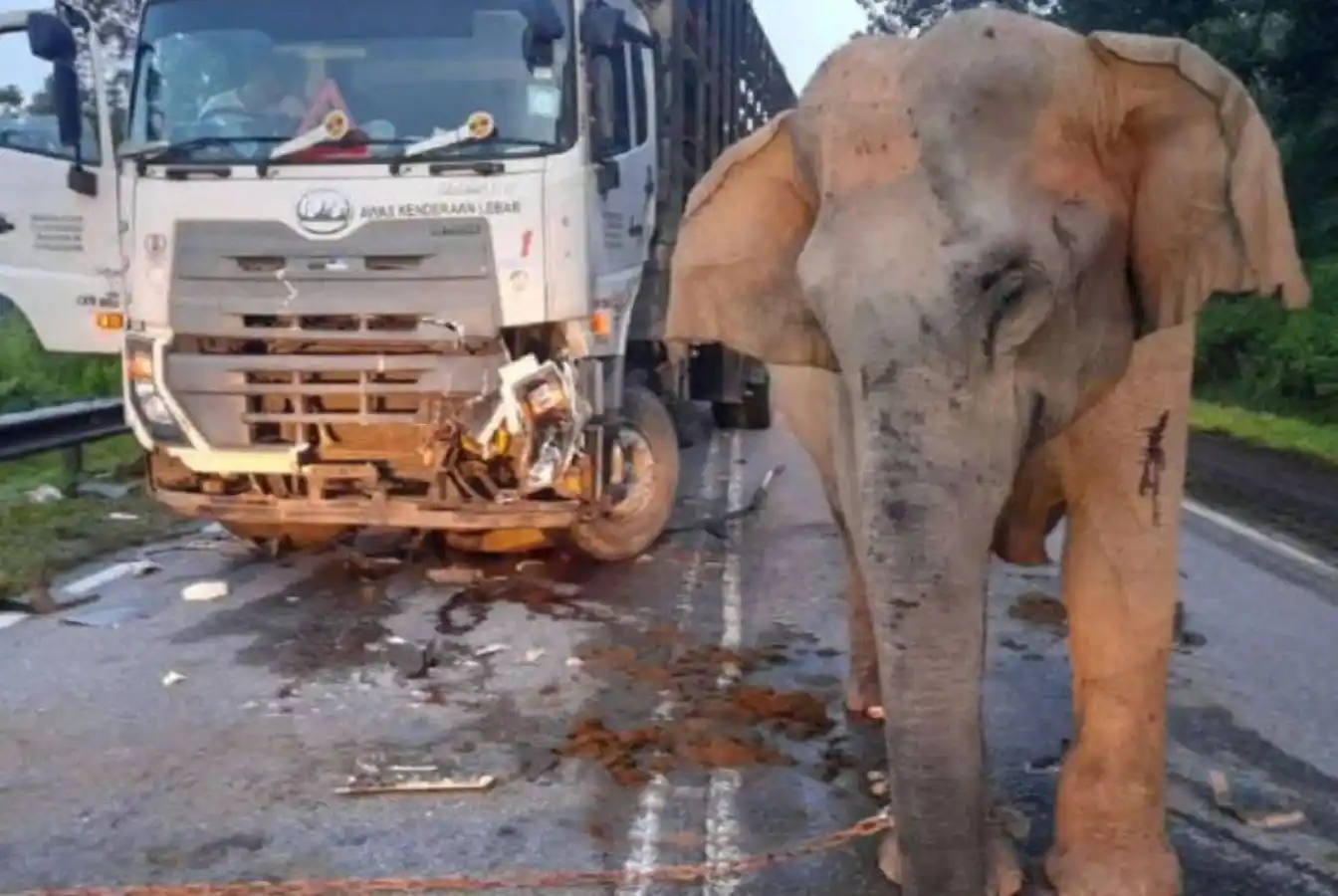A heartbreaking incident on Malaysia’s East-West Highway, where a mother elephant lost her calf to a lorry collision, has ignited widespread grief and urgent demands for better wildlife protection. The tragedy, captured in a viral video shared on Mother’s Day, May 11, 2025, shows the mother elephant desperately trying to free her calf, pinned under the vehicle, before being sedated and removed by wildlife officials. As public outcry grows, Malaysians are pressing authorities to implement measures to prevent such incidents, highlighting the broader challenges of human-wildlife conflict in a rapidly developing region.
A Mother’s Despair Moves a Nation
The incident occurred on the Gerik-Jeli stretch of the East-West Highway, a known hotspot for wildlife crossings, particularly for elephants. According to reports, the lorry struck the calf, fatally injuring it, as it attempted to cross the road. The mother elephant, in a frantic bid to save her offspring, reportedly charged at the vehicle, an act wildlife experts describe as a natural protective instinct rather than aggression. Unable to free the calf, she refused to leave the scene, a poignant display of grief that resonated deeply with viewers online.
Social media platforms were flooded with reactions, many tagging key government figures such as Transport Minister Anthony Loke, Natural Resources and Environmental Sustainability Minister Nik Nazmi Nik Ahmad, and Works Minister Datuk Seri Alexander Nanta Linggi. “To the driver, it is just an accident; he will move on with his day-to-day job, but to the mother elephant, she just lost her baby” wrote Titanium Samarium Wong on Facebook, emphasizing the emotional intelligence of elephants. “They have feelings; just imagine a mother losing her child. Authorities really have to do something to minimize this kind of incident” he added.
Others echoed similar sentiments. “My heart aches every time I watch this in the media” shared Zue Razak, while countless netizens called for systemic changes to protect Malaysia’s wildlife. The calf was later buried in an undisclosed location, a quiet end to a tragedy that has sparked a loud call for action.
A Highway of Hazard for Wildlife
The East-West Highway, cutting through dense forest areas, has long been a perilous corridor for animals. Signboards along the Gerik-Jeli stretch remind drivers to slow down, but incidents like this underscore the inadequacy of current measures. Elephants, which often travel in family groups, are particularly vulnerable as they cross roads in search of food or water, especially during migration seasons. Conservationists note that Malaysia’s rapid infrastructure development, while boosting connectivity, has fragmented natural habitats, forcing wildlife into dangerous encounters with human activity.
Public suggestions for solutions have poured in alongside the grief. Evelin Ruman proposed the construction of wildlife overpasses or underpasses, a model successfully implemented in countries like Canada and the Netherlands to allow animals safe passage. Lau Sook Mei advocated for stricter speed limits in known crossing zones, while M Tirmizi MY suggested installing railings to prevent animals from straying onto roads. “In areas where wild animals are known to roam and cross, why not build a crossing?” he questioned, urging ministers to act. June Thien YC recommended more speed cameras to enforce compliance, a measure that could deter reckless driving in sensitive areas.
Questions of Accountability and Action
The driver of the lorry claimed the calf had darted out of the forest unexpectedly, a statement that has fueled debate over accountability. While some netizens called for action against the driver, others recognized the complexity of such accidents, pointing to systemic issues over individual blame. Wildlife officials have not released details on whether charges will be filed, and the focus has largely shifted to preventive strategies. “What action will be taken to prevent such incidents in the future? What steps are being taken to reduce animal-vehicle collisions or even stop them?” asked Vemanna Appannah, capturing the public’s demand for concrete policies.
Malaysia’s Department of Wildlife and National Parks (PERHILITAN) has faced criticism in the past for slow responses to human-wildlife conflict, though officials were quick to intervene in this case by sedating and relocating the mother elephant. However, without broader infrastructure changes or enforcement, such interventions remain reactive rather than preventive. The incident also raises questions about the effectiveness of existing conservation programs, especially for endangered species like the Asian elephant, whose population in Malaysia is estimated at fewer than 1,500 due to habitat loss and poaching.
The Bigger Picture: Balancing Development and Conservation
This tragedy is a microcosm of the larger tension between development and environmental preservation in Southeast Asia. Malaysia, like many of its neighbors, has prioritized economic growth through infrastructure projects, often at the expense of natural ecosystems. Roads, plantations, and urban expansion have encroached on wildlife habitats, leaving animals with fewer safe spaces to roam. Elephants, revered in local culture as symbols of strength and wisdom, are increasingly caught in this clash, with vehicle collisions becoming a leading cause of death alongside poaching.
Conservation groups have long called for integrated land-use planning that prioritizes wildlife corridors—uninterrupted paths allowing animals to move between fragmented habitats. Such corridors, if paired with physical barriers like fences or overpasses, could significantly reduce roadkill incidents. However, funding and political will remain obstacles. The cost of building a single wildlife overpass can run into millions of Malaysian Ringgit (MYR), with estimates for a small structure at around MYR 3.5 million (US$750,000 as of May 2025 exchange rates). While this is a substantial investment, advocates argue that the long-term benefits—both ecological and ethical—justify the expense.
Public sentiment, amplified by this viral incident, may pressure policymakers to act. Social media has proven a powerful tool in galvanizing support for conservation, with hashtags related to the elephant tragedy trending across platforms. Yet, translating online outrage into tangible policy remains a challenge, especially in a country where environmental issues often compete with economic and political priorities.
Looking Ahead: A Call for Compassionate Coexistence
As Malaysia mourns the loss of the elephant calf, the mother’s unwavering refusal to abandon her child serves as a stark reminder of the emotional depth of these majestic creatures. Her grief, mirrored by the anguish of countless Malaysians, underscores a shared desire for a future where humans and wildlife can coexist without tragedy. Whether through overpasses, stricter regulations, or public awareness campaigns, the path forward demands innovative solutions and collective will.
For now, the East-West Highway remains a somber symbol of the cost of progress. As calls for change grow louder, the question lingers: will this heartbreak be the catalyst for lasting protection, or merely another fleeting moment of outrage in an ongoing struggle? Only time—and the commitment of those in power—will tell.
















